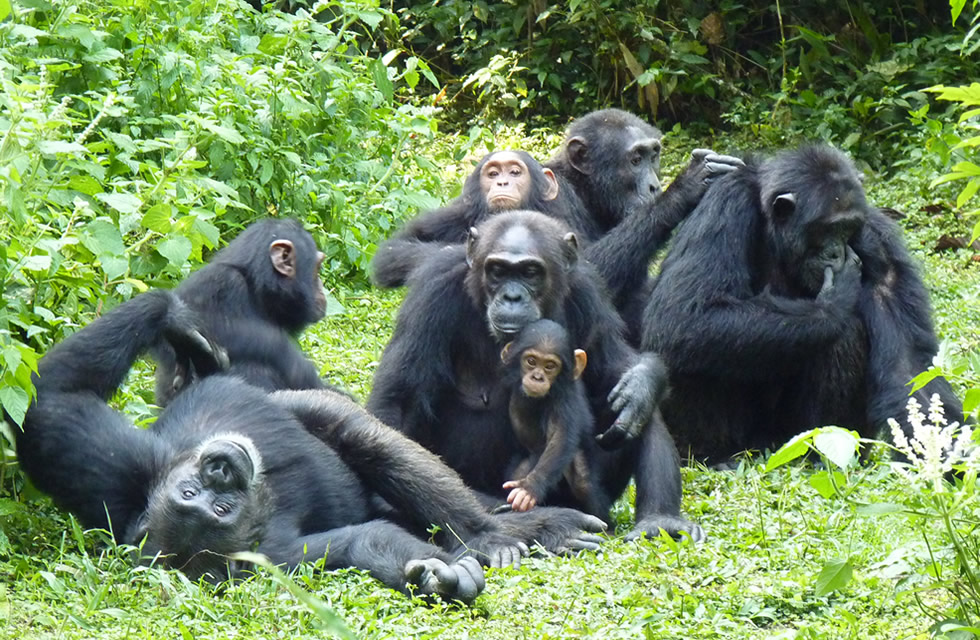Your cart is currently empty!

Meet the Gorillas & Chimpanzees in Uganda
As far as tourism is concerned, whenever one hears Uganda, what comes in any foreigners mind is the primate excursions that are always carried out in this country. And not only that, but what also rings a bell to them is the gorilla tracking as well as chimpanzee trekking. However, there are distinctive features that separate these two primates in the way they are tracked and how best one can prepare for both to have an ultimate experience.
Where they are both found in Uganda;
Chimpanzees in Uganda are located in different places but habituated chimpanzees only exist in Kibale National Park located in western Uganda, Kyambura Gorge located in Queen Elizabeth National Park, Kalinzu forest located closer to Queen Elizabeth National Park and Budongo Forest in Murchison Falls National Park located in Northern Uganda. We also have orphaned chimpanzees in Ngamba Island which is approximately 23 km in Lake Victoria and can be accessed by boats.
On the other hand, habituated gorillas are found in Bwindi Impenetrable National Park and Mgahinga National Park. According to the 2013 mountain gorilla census, it was discovered that Bwindi Impenetrable National park has almost half the number of mountain gorillas in the whole while the other population of gorillas are in the Virunga Ranges shared between Uganda, Rwanda and the Democratic republic of Congo. Today Bwindi is one of the most popular parks for gorilla safaris on the African continent.
Gorilla and chimp trekking experience compared
When compared, gorilla tracking is a more organized activity both in Uganda and Rwanda and chances of seeing gorillas is above 90%. This is because gorillas live in families each headed by a dominant silver back. In Bwindi Impenetrable National Park, the activity is so organized in such a way that early in the morning, there is an advanced team that goes to the forest to look for where the gorillas would have slept and once they find them, then they communicate to the park head quarters to inform the guides where gorillas are. It’s from here that tourists plus their guide will start the trek to look for gorillas starting from where they slept the previous night until they find them. Once they have found them, they are given one hour to observe and take photographs.
Chimpanzee trekking on the other hand is not as organized as gorilla trekking and chances are high in Kibale National Park and Budongo forest to other places such as Kyambura Gorge and Kalinzu forest. The same process of having an advanced team applies to chimps but chimpanzees on the other hand live in communities of around 100 individuals or more and during the day, these communities breakup into small parties to reduce on food competition. Each party is therefore tracked by 6 people. Once you have found the chimpanzees, you are allowed only one hour to view and photograph them.
Family composition
A family of habituated gorillas is trekked by a maximum of 8 people in Bwindi Impenetrable National Park and Mgahinga National Park while Chimpanzee parties in Kibale National Park is restricted to only 6 people. While a habituated gorilla family can only be seen by a maximum of 8 people PER DAY, chimpanzee parties are trekked twice in a day (morning and afternoon). Taking a close look at chimp trekking in Kibale National Park, a maximum of 18 people do trek chimps both in the morning and in the afternoon. It is arranged in such a way that each chimpanzee party is trekked by 6 people thus 3 parties for 18 people. The fact that chimpanzees keep on breaking into small parties and regrouping, at a given point, you might find yourselves trekking the same party (18 people) they can join together. This tends to cause confusion amongst tourists if not briefed very well. This sometimes leads to congestion and kills the whole Eco- experience as expected by clients. Mountain gorillas tend to be on ground in most cases and depending on the height of the vegetation, they are better seen compared to chimpanzees which are in most cases up in the trees (Not all the time though as so many people have found them on ground).
What to pack for gorilla or chimp trekking
Both gorilla and chimp trekking requires one to have hiking boots, garden gloves, long sleeved trousers and shirts, rain jackets, sun glasses, huts, a hiking stick and some energy giving foods to give you that extra strength when needed. You might not need a porter for chimp trekking in Kibale but we highly recommend one for Bwindi Impenetrable National Park for your gorilla trek.
Gorilla and Chimp permits
In Uganda, you require a permit to either trek gorillas or chimpanzees. Gorilla tracking permit for Bwindi Impenetrable National Park costs USD600.00 which normally goes down from that in low seasons (Feb-may) to the tune of USD350.00. enabling you to save USD150.00. The above includes trekking gorillas, a guide for the trek and park entrance fees. Chimpanzee trekking permits in Uganda vary according to where you will be trekking them. In Kibale, a permit is USD150 while in Kyambura is at USD50.00 per person and includes guide, park entrance and viewing chimps.
Distances compared
Gorilla trekking is done in Bwindi and Mgahinga and they are approximately 8-9 hours from Kampala while driving and it also depends on which side of Bwindi you are going to. If you are flying, then it might take you around about one and half hours to Bwindi or Kisoro. Kibale National Park is about 5-6 hours from Kampala; Kyambura Gorge is approximately 7-8 hours drive from Kampala while Budongo is also approximately 5-6 hours drive to northern Uganda.
by
Tags:
Leave a Reply